LeetCode 刷题笔记(七)
LeetCode 刷题笔记(七)
写完了CPP版tinyhttpd,过来刷会儿题
这次的主题是回溯和链表
ID:46
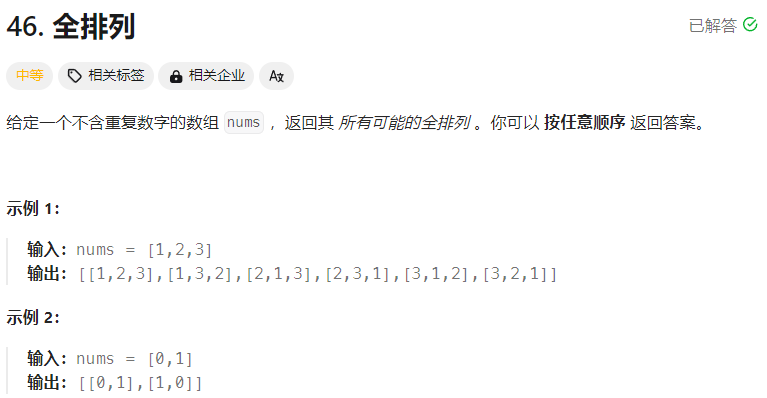
思路历程:
今天看了代码随想录的视频,介绍了回溯算法的基本思路
就是递归中,判断边界
然后遍历元素,处理数据,调用递归,撤销处理(回溯)
值得注意的是,回溯算法一般会用到set,如果不用set用vector的话,记得加一个状态数组
如下:
class Solution {
public:
vector<vector<int>> res;
vector<int> sub_res;
void bkt(vector<int>& nums, vector<bool>& used) {
if (sub_res.size() == nums.size()) {
res.push_back(sub_res);
return;
}
for (int i = 0; i < nums.size(); ++i) {
if (!used[i]) {
used[i] = true;
sub_res.push_back(nums[i]);
bkt(nums, used); // 递归调用
// 回溯
used[i] = false;
sub_res.pop_back();
}
}
}
vector<vector<int>> permute(vector<int>& nums) {
vector<bool> used(nums.size(), false); // 初始化为未使用
bkt(nums, used);
return res;
}
};
answer:(unordered_set)
class Solution {
public:
vector<vector<int>>res;
vector<int>sub_res;
void bkt(unordered_set<int> all_nums){
if(all_nums.empty()){
res.push_back(sub_res);
return ;
}
for(auto iter=all_nums.begin();iter!=all_nums.end();++iter){
int c=*iter;
sub_res.push_back(c);
unordered_set<int>temp=all_nums;
temp.erase(c);
bkt(temp);
sub_res.pop_back();
}
}
vector<vector<int>> permute(vector<int>& nums) {
unordered_set<int>all_nums;
for(auto c:nums)all_nums.insert(c);
bkt(all_nums);
return res;
}
};
ID:78

思路历程:
感觉所谓的模板不能以偏概全
不一定会有遍历,返回和处理数据是必要的
子集可以是这样,我从数组头出发,选择要当前的或者不要,然后往后走(重新调用)
answer:
class Solution {
public:
vector<vector<int>>res;
vector<int>sub_res;
void bkt(int now,vector<int>&nums,int n){
if(now==n){
res.push_back(sub_res);
return;
}
sub_res.push_back(nums[now]);
bkt(now+1,nums,n);
sub_res.pop_back();
bkt(now+1,nums,n);
}
vector<vector<int>> subsets(vector<int>& nums) {
int n=nums.size();
bkt(0,nums,n);
return res;
}
};
ID:21
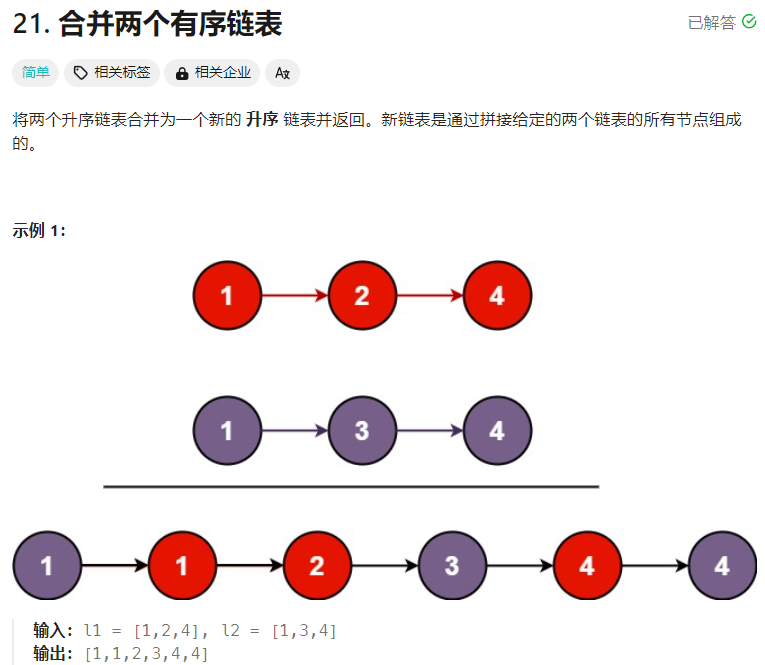
思路历程:
非常的简单,不要想复杂,拿出一格头节点和队列一样,一个个收进来就行
answer:
/**
* Definition for singly-linked list.
* struct ListNode {
* int val;
* ListNode *next;
* ListNode() : val(0), next(nullptr) {}
* ListNode(int x) : val(x), next(nullptr) {}
* ListNode(int x, ListNode *next) : val(x), next(next) {}
* };
*/
class Solution {
public:
ListNode* mergeTwoLists(ListNode* list1, ListNode* list2) {
ListNode* res=nullptr;
ListNode* fin_res=nullptr;
if(list1&&list2){
fin_res=list1->val<=list2->val?list1:list2;
}else{
if(list1)fin_res=list1;
if(list2)fin_res=list2;
return fin_res;
}
ListNode*tmp;
while(list1&&list2){
if(list1->val<=list2->val){
if(!res){
res=list1;
}else{
res->next=list1;
res=res->next;
}
list1=list1->next;
}else{
if(!res){
res=list2;
}else{
res->next=list2;
res=res->next;
}
list2=list2->next;
}
}
if(list1)res->next=list1;
if(list2)res->next=list2;
return fin_res;
}
};
ID:2
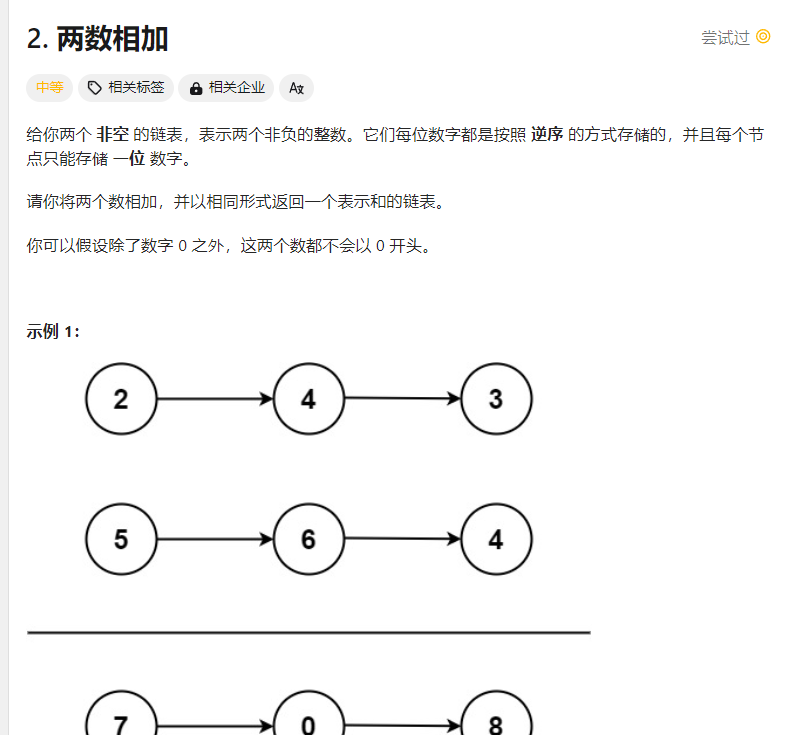
思路历程:
一开始我还是想的比较简单,一环环往后就行,遇到进位就记录,但到后面真有点恶心到了
上一轮的进位会影响到这一轮,应该先存节点,再考虑进位,不然会相互干扰
同时如果遇到有长短链表,建议先增长至一直,不要和我一样偷懒,加完一条后,再处理剩下那条
新思路中有一点要注意的是,补0节点时,最好从尾节点开始,而不是尾节点->next
answer:
/**
* Definition for singly-linked list.
* struct ListNode {
* int val;
* ListNode *next;
* ListNode() : val(0), next(nullptr) {}
* ListNode(int x) : val(x), next(nullptr) {}
* ListNode(int x, ListNode *next) : val(x), next(next) {}
* };
*/
class Solution {
public:
ListNode* addTwoNumbers(ListNode* l1, ListNode* l2) {
ListNode*res=nullptr;
ListNode*fin_res=nullptr;
int flag=0;
ListNode*head1=l1;ListNode*head2=l2;
int length1=0,length2=0;
while(head1->next){
length1++;head1=head1->next;
}
while(head2->next){
length2++;head2=head2->next;
}
if(l1->val==0&&length1==1)return l2;
if(l2->val==0&&length2==1)return l1;
while(length1<length2){
head1->next=new ListNode(0);
head1=head1->next;
length1++;
}
while(length2<length1){
head2->next=new ListNode(0);
head2=head2->next;
length2++;
}
if((l1->val+l2->val)/10)flag=1;
res=new ListNode((l1->val+l2->val)%10);
l1=l1->next;l2=l2->next;fin_res=res;
while(l1&&l2){
int sum=l1->val+l2->val+flag;//上个flag
res->next=new ListNode(sum%10);
if(flag)flag=0;
l1=l1->next;l2=l2->next;res=res->next;
if(sum>=10)flag=1;
}
if(flag)res->next=new ListNode(1);
return fin_res;
}
};
ID:19
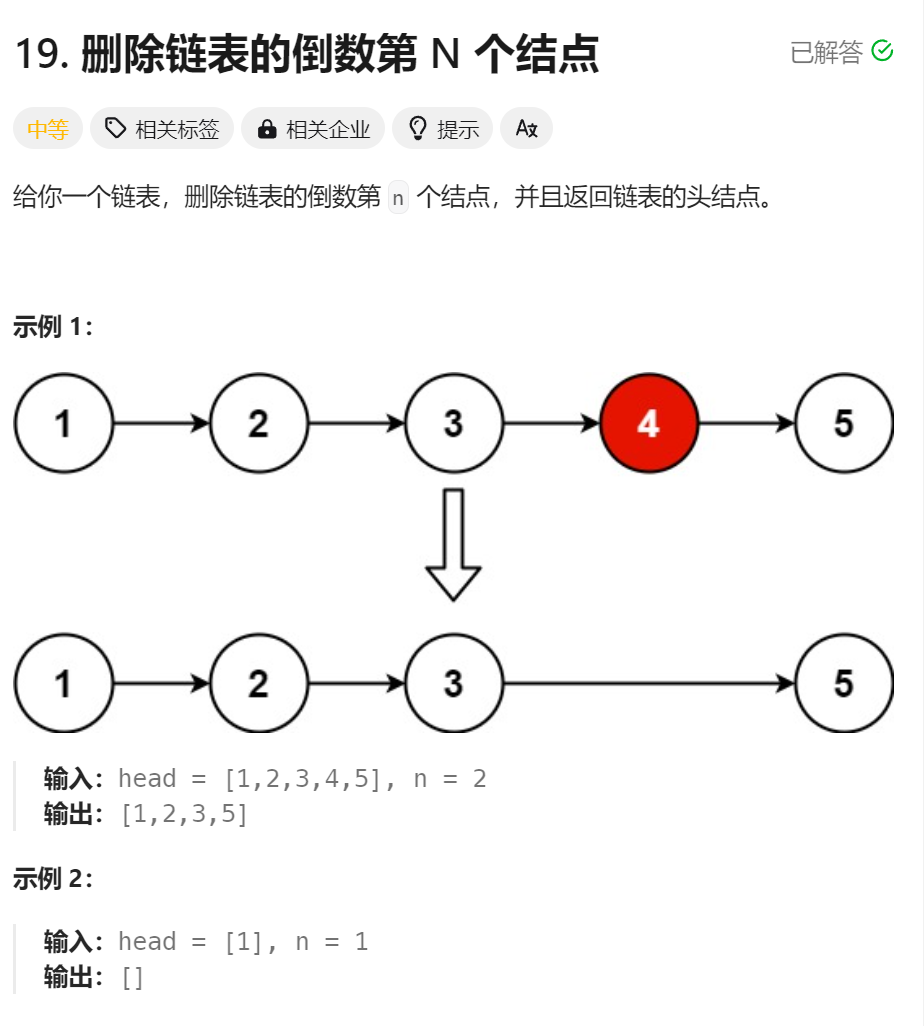
思路历程:
思考起来会比较简单,遍历链表记录长度,然后获取要删除节点的下标,然后再次遍历处理即可
注意的点是如果要删除的是第一个节点,直接返回head->next即可
answer:
/**
* Definition for singly-linked list.
* struct ListNode {
* int val;
* ListNode *next;
* ListNode() : val(0), next(nullptr) {}
* ListNode(int x) : val(x), next(nullptr) {}
* ListNode(int x, ListNode *next) : val(x), next(next) {}
* };
*/
class Solution {
public:
ListNode* removeNthFromEnd(ListNode* head, int n) {
int length=0;
ListNode*tmp=head;
while(tmp){
length++;tmp=tmp->next;
}
tmp=head;ListNode* res;
int idx=length-n;
if(!idx){
return head->next;
}else{
int i=0;
while(i<idx-1){
tmp=tmp->next;
i++;
}
tmp->next=tmp->next->next;
}
return head;
}
};
ID:24
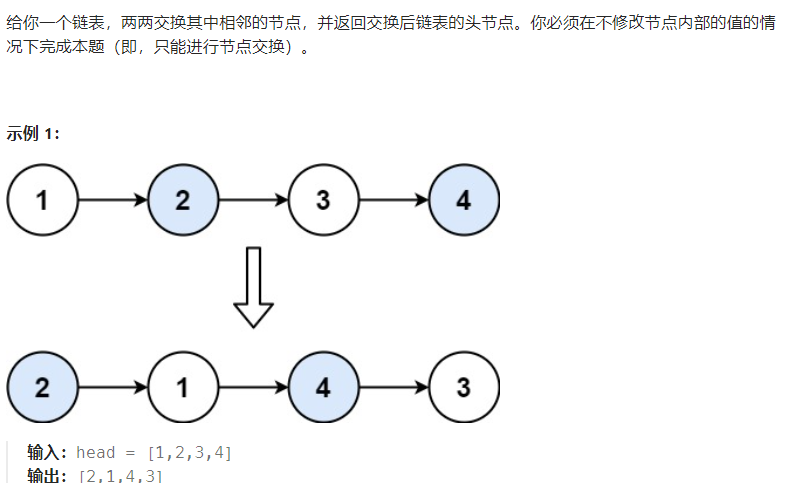
思路历程:
有一说一,做完还是有点蒙,
总体思路是,每次遇到下标为奇数,就去交换位置,
换的时候,pre->next=back;now->next=back->next;back->next=now;
不换的时候 pre=now;now=now->next;back=now->next;
注意考虑第一个pre为nullptr的时候
answer:
/**
* Definition for singly-linked list.
* struct ListNode {
* int val;
* ListNode *next;
* ListNode() : val(0), next(nullptr) {}
* ListNode(int x) : val(x), next(nullptr) {}
* ListNode(int x, ListNode *next) : val(x), next(next) {}
* };
*/
class Solution {
public:
ListNode* swapPairs(ListNode* head) {
ListNode*pre=nullptr;
ListNode*now;ListNode*back;ListNode*tmp=head;
int length=0;
while(tmp){
length++;tmp=tmp->next;
}
if(length<=1)return head;
std::cout<<length<<std::endl;
tmp=head;now=head;back=head->next;
int i=1;
ListNode* res;
while(i<length){
i++;
if(i%2==0){
if(pre){
pre->next=back;
now->next=back->next;
back->next=now;
}else{
now->next=back->next;
back->next=now;
pre=back;
back=now->next;
}
if(i==2)res=pre;
continue;
}
pre=now;
now=now->next;
back=now->next;
}
return res;
}
};
ID:138
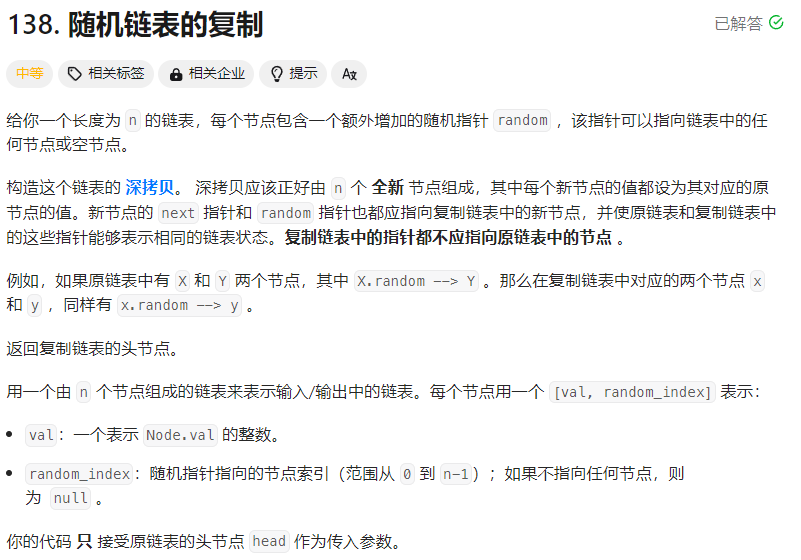
思路历程:
next指针拷贝非常简单,主要问题在于random怎么实现深拷贝
我一开始想的是,存下标,自定义一个计数器,然后用map存两边的下标,就能实现再次遍历的时候深拷贝random
但问题在于,我拷贝下标是不够的,因为我random指向的是指针而不是下标,所以优化一下
我们选择存两边对应的地址(指针)那么我只要再次遍历时,取出原节点的random,然后放入map,就可以拿到本节点的random地址
answer:
/*
// Definition for a Node.
class Node {
public:
int val;
Node* next;
Node* random;
Node(int _val) {
val = _val;
next = NULL;
random = NULL;
}
};
*/
class Solution {
public:
Node* copyRandomList(Node* head) {
if(!head)return NULL;
Node*tmp=head;tmp=tmp->next;
Node*res=new Node(head->val);
Node*node=res;
map<Node*,Node*> ptr_hash;//存下标和映射下标
ptr_hash.insert({head,res});
while(tmp){
node->next=new Node(tmp->val);
node=node->next;
ptr_hash.insert({tmp,node});
tmp=tmp->next;
}
tmp=head;node=res;
while(tmp){
node->random=ptr_hash[tmp->random];
node=node->next;
tmp=tmp->next;
}
return res;
}
};
ID:148
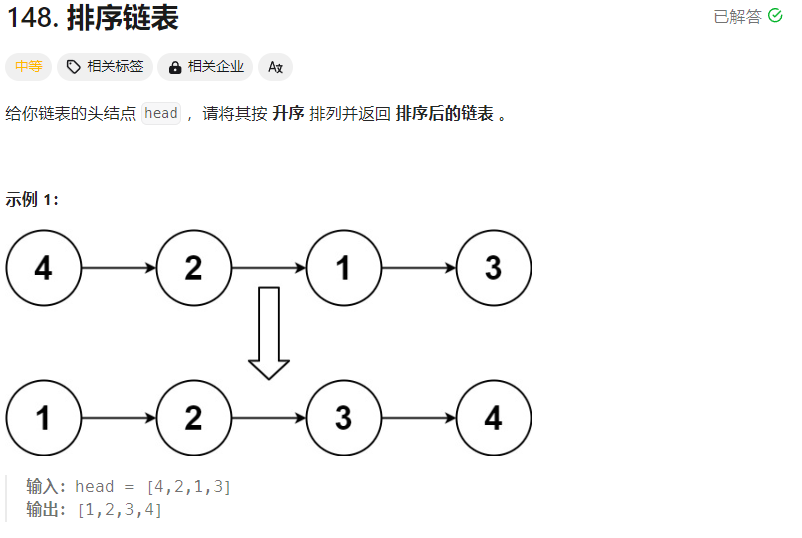
思路历程:
如果不考虑空间和时间复杂度会很简单,但如果考虑的话,就比较麻烦了
比如说用到归并排序的思想,就能实现O(nlogn)时间复杂度和O(logn)空间复杂度

answer(暴力):
/**
* Definition for singly-linked list.
* struct ListNode {
* int val;
* ListNode *next;
* ListNode() : val(0), next(nullptr) {}
* ListNode(int x) : val(x), next(nullptr) {}
* ListNode(int x, ListNode *next) : val(x), next(next) {}
* };
*/
class Solution {
public:
ListNode* sortList(ListNode* head) {
if(!head)return nullptr;
ListNode*node =head;
vector<int> nums;
while(node){
nums.push_back(node->val);
node=node->next;
}
sort(nums.begin(),nums.end());
ListNode*res=nullptr;
ListNode*fin;
for(auto c:nums){
if(!res){
res=new ListNode(c);
fin=res;
}else{
res->next=new ListNode(c);
res=res->next;
}
}
return fin;
}
};
继续加油,许愿快速OC
 微信
微信
 支付宝
支付宝
